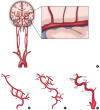Emerging Concept of Intracranial Arterial Diseases: The Role of High Resolution Vessel Wall MRI
- PMID: 38326705
- PMCID: PMC10850450
- DOI: 10.5853/jos.2023.02481
Emerging Concept of Intracranial Arterial Diseases: The Role of High Resolution Vessel Wall MRI
Abstract
Intracranial arterial disease (ICAD) is a heterogeneous condition characterized by distinct pathologies, including atherosclerosis. Advances in magnetic resonance technology have enabled the visualization of intracranial arteries using high-resolution vessel wall imaging (HR-VWI). This review summarizes the anatomical, embryological, and histological differences between the intracranial and extracranial arteries. Next, we review the heterogeneous pathophysiology of ICAD, including atherosclerosis, moyamoya or RNF213 spectrum disease, intracranial dissection, and vasculitis. We also discuss how advances in HR-VWI can be used to differentiate ICAD etiologies. We emphasize that one should consider clinical presentation and timing of imaging in the absence of pathology-radiology correlation data. Future research should focus on understanding the temporal profile of HR-VWI findings and developing quantitative interpretative approaches to improve the decision-making and management of ICAD.
Keywords: Arterial dissection; Atherosclerotic plaque; Intracranial arterial diseases; Magnetic resonance imaging; Moyamoya disease.
Conflict of interest statement
The authors have no financial conflicts of interest.
Figures




References
-
- Gorelick PB, Wong KS, Bae HJ, Pandey DK. Large artery intracranial occlusive disease: a large worldwide burden but a relatively neglected frontier. Stroke. 2008;39:2396–2399. - PubMed
Publication types
Grants and funding
LinkOut - more resources
Full Text Sources

